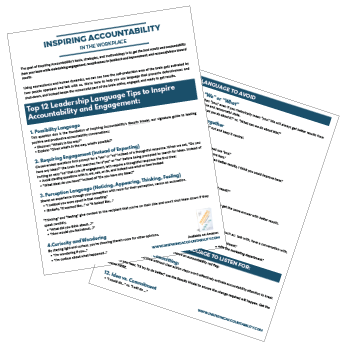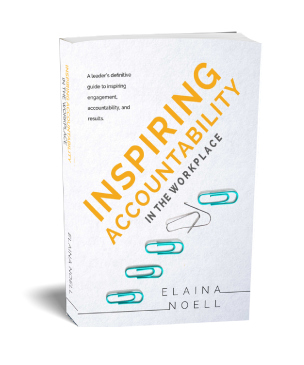How to Set Goals and Expectations for Employees

August 7, 2020
How to Set Goals and Expectations for Employees
With Covid-19, managing remote employees is the new norm. These days, when I get asked about how to set goals and expectations for employees, it usually comes from a concern that they can’t see the employee working. Although this was never a true form of accountability, it did make leaders feel better. Without this cue, learning how to set goats and expectations for employees has never been so important.
Here at Inspiring Accountability, we upgrade expectations to Accountability Anchors.
Accountability Anchors convert expectations into effective accountability tools. A leader can then effectively “anchor” the employee to a clear expectation, closing the distance between the actual result and your expectation.
Much like a ship at sea, accountability anchor keeps the employee tethered to the ask, task, or project and is a clear point of reference for what is expected and what defines success.
Without an anchor, employees can drift, and drifting employees don’t know if they’ve made progress. Employees should know how well they are meeting expectations to remain incentivized to engage.
The goal is to create a Desired Result so clear that, when leading accountability conversations with our signature Results Model, it becomes inevitable that an employee will successfully achieve it.
How to Set Goals and Expectations for Employees:
We upgrade expectations to Accountability Anchors using the Accountability Anchor Conversion Checklist:
- Identify the Desired Result
- Is there a clear moment of achievement?
- Is it achievable within three months or less?
- Is it stated as what you want (not as stopping what you don’t want)?
- What are the Actionably Clear Expectations and Specifications?
- What is the contribution context?
- Is it confirmed in writing?
Let’s look at each step in more detail.
1. Identify the Desired Result
You probably have this in mind. What is your request or new expectation? Go ahead and write it down. We’re about to upgrade it to an accountability anchor!
2. Is there a clear moment of achievement?
How will you know your ask has been precisely fulfilled? How will your employee know he or she has successfully met the expectation, worthy of acknowledgment and neurochemical celebration?
Take, for example, smart watches and activity trackers. These capitalize on the value of tracking something specific because it feels good to know you fulfilled your chosen metric. “Congratulations – you moved more today!” is hardly as satisfying as knowing you got in your 10,000 steps a day.
Clear expectations facilitate clear moments of achievement, which offer the best neurochemical rewards. We talk more about creating effective and incentivizing rewards in our book, Inspiring Accountability in the Workplace.
A clear moment of achievement allows for more effective progress tracking, greater reward and motivation, and a clearer reference to adjust habits and patterns.
To determine a clear moment of achievement, you can ask yourself:
- Where is the first place I’d like to see evidence of this success?
- How will my employee and I both know the expectation has been exactly met?
- How can I be more specific about what successful completion looks like?
- What definitions are being assumed or would benefit from clearer definition?
3. Is it achievable within three months or less?
Once the timeframe edges out past about three months, it becomes too long term and not urgent enough for the brain to warrant the same effort as more “important” priorities. Anticipated neurochemical rewards are too distant to be incentivizing, so you create a dull Desired Result.
If your Desired Result can’t be successfully completed within three months, ask yourself questions like:
- What’s the soonest indication I could see that my employee is making progress?
- What is the first evidence of success or sign of progress that can be completed within three months?
4. Is the Desired Result framed as what you want (not as stopping what you don’t want)?
Stating what you don’t want is rarely as helpful as stating what you do want. It is more helpful and efficient to help the employee’s brain focus on the behavior or outcome to demonstrate, instead of what to avoid.
Check if your Desired Result is stated in the positive by asking yourself:
- Is what I’m asking for reflecting the result, behavior, or change I want to see? Or, is it a result, behavior, or change I want to stop?
5. What are the Actionably Clear Expectations and Specifications (ACES)?
If an employee is missing specified details on deliverables, you can create an Actionably Clear Expectations and Specifications (ACES) checklist.
ACES provide a clear reference for the exact Desired Result requirements needed. ACES take into account the details, format, and specifications necessary to successfully meet expectations.
Successful ACES eliminate an, “I didn’t know that!” excuse and prevent unproductive efforts.
To discover helpful ACES, you can ask yourself:
- What does the employee need to include to be successful?
- Is there anything they’ve often forgotten to include or to be in compliance with?
- Is there anything I tend to forget to include that would be useful to ask for proactively?
- What else will I need to see from the employee to be 100% satisfied they’ve met my expectations?
- What words have I already included that could be better defined?
6. What is the contribution context?
If you have ever been irritated by the phrase from an authority figure, “Because I said so,” then you probably understand that it is not the ideal way to inspire engagement toward Desired Results. We are more incentivized to invest effort and engage in required action when we understand the impact of our efforts.
Providing contribution context intentionally and proactively communicates why an ask, task, project, or behavior is important. This sets the stage for employees to be seen as contributing meaningfully, which naturally incentivizes engagement.
To identify the contribution context, you can ask yourself:
- Why does the Desired Result matter beyond personal preference? What is important about the Desired Result? To whom or what does it meaningfully contribute?
- What is the negative impact of not having the Desired Result currently? To whom, what, when, how or where does this negatively contribute?
- What is the expected positive impact of having the Desired Result fulfilled? To whom, what, when, how, or where will it positively contribute?
- How will fulfilling this help the employee meet his or her need to be seen as contributing, competent, and important?
Despite the many prompt questions, which I hope you found helpful, this process is actually really simple. Let’s look at a quick example!
EXAMPLE:
Let’s walk through a challenge for Mary, a manager, who has been struggling to hold her employee, Mario, accountable for showing up to Zoom meetings late.
Mary’s Desired Result is for Mario to “stop being late to meetings.”
After going through the checklist, here’s what Mary came up with:
“Mario, I’d like you to work on being on time to our Zoom team meetings. This matters because you are an important contributor, and I want your input in meetings. Because our team is busier than ever, I’m going to start meetings on time, and I don’t want you to miss anything. Although coming in late is mildly disruptive, more importantly, I need your input and so does the team. I don’t want you to miss your opportunity to contribute or our opportunity to get your valued input.
I’m asking you be logged into the meeting, ready to begin meetings with your project updates, at the calendared start time.”
Who wouldn’t be inspired to show up on time when presented with this context?
Can you spot each fulfilled part of the Accountability Anchor Conversion Checklist?
Although it may seem like overkill, it is extremely effective at getting exactly what she’s requesting. And Mario will likely remain engaged, receptive, and resourceful, a key goal of the Inspiring Accountability approach.
Of course, accountability always requires revisiting. Mary will want to revisit Mario’s progress in their 1-1’s until he’s met her expectation satisfactorily. We advocate using the Results Model for this Revisiting step and to hold effective feedback and accountability conversations.
We hope this helped you answer how to set goals and expectations for employees, and that you’re on the path to get the desired results you need from your team!
GET ACCESS TO OUR BEST TIPS
Download our Top 12 Leadership Language Tips to Inspire Accountability and Employee Engagement



